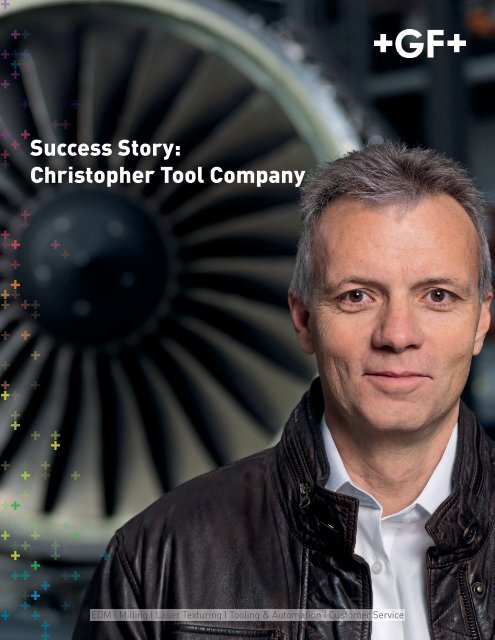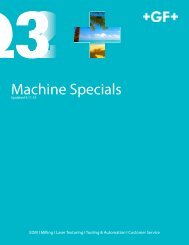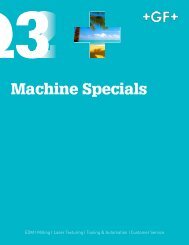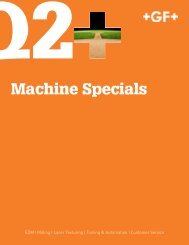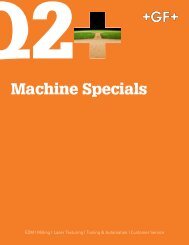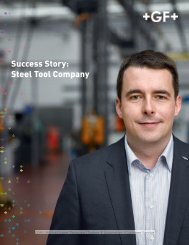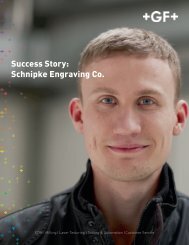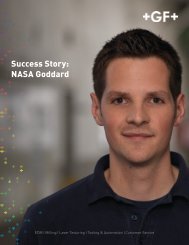Christopher Tool Company
You also want an ePaper? Increase the reach of your titles
YUMPU automatically turns print PDFs into web optimized ePapers that Google loves.
Success Story:<br />
<strong>Christopher</strong> <strong>Tool</strong> <strong>Company</strong><br />
EDM I Milling I Laser Texturing I <strong>Tool</strong>ing & Automation I Customer Service
Zero Defects Means Zero Defects at Aerospace Shop<br />
Since machining its first aerospace part in the mid-1960s,<br />
<strong>Christopher</strong> <strong>Tool</strong> & Manufacturing Co. (Solon, Ohio) has<br />
always met the continuously tightening part-tolerance<br />
requirements of its customers. This success includes<br />
overcoming one particular challenge that began in 2007,<br />
when the initiative of “zero defects” was introduced into the<br />
aerospace industry. While some manufacturers supplying<br />
the industry took the concept with a grain of salt, <strong>Christopher</strong><br />
<strong>Tool</strong> has taken substantial steps to attain that level of<br />
part quality.<br />
The concept of zero defects is very literal, and the mandate<br />
is well enforced. So, aerospace shops continuing to be successful<br />
and competitive, such as <strong>Christopher</strong> <strong>Tool</strong>, are those<br />
now producing perfect parts that are always within specified<br />
tolerances.<br />
“These days, aerospace OEMs will refuse any parts that<br />
deviate from tolerance,” said Patrick <strong>Christopher</strong>, president<br />
of <strong>Christopher</strong> <strong>Tool</strong> & Manufacturing Co. “All parts must be<br />
to print and documented with the proper paperwork, and<br />
shops must take initiatives and have corrective measures<br />
and benchmarking in place to ensure any past mistakes will<br />
not be repeated.”<br />
All of this “mandatory continuous improvement” he said<br />
has significantly changed the aerospace industry landscape.<br />
Quality is paramount and must be maintained for<br />
parts that grow increasingly more complex. To fulfill these<br />
requirements, the shop constantly invests in expanding its<br />
technological capabilities – two recent examples being full<br />
simultaneous 5-axis high-speed machining and rotary axis<br />
wire electrical discharge machining (EDM).<br />
Because of these two machines, the shop can now process<br />
previously farmed-out parts in-house as well as shorten<br />
cycle times for many of its existing components. But most<br />
importantly, the machines make it easier to achieve better<br />
surface finishes and much tighter tolerances.<br />
Propelled by its heavy involvement with the Joint<br />
Strike Fighter program, <strong>Christopher</strong> <strong>Tool</strong> added a GF<br />
AgieCharmilles HSM (high-speed machining) MIKRON 600U<br />
LP full 5-axis milling machine and CUT 200 wire EDM to its<br />
existing 35 or so pieces of CNC equipment. With a tilt/rotary<br />
table design, the milling machine delivers +30/-110 degree<br />
B-axis travel and 360 degrees in C. The shop’s CUT 200 wire<br />
EDM features a rotary fourth (B) axis specifically for complex<br />
part geometries.<br />
The HSM 600U LP’s high speed comes from a 36,000-rpm<br />
32-hp spindle and rapid traverse speed of 196 ft/minute (60<br />
m/min). And for continuous production, it is equipped with<br />
an integrated pallet-changing system.<br />
The large-size milling machine features linear motors on its<br />
main axes and optimized direct-drive motors for its B and C<br />
axes. Both the GF AgieCharmilles milling machine and wire<br />
EDM incorporate glass scale positioning that provides <strong>Christopher</strong><br />
<strong>Tool</strong> with extremely high precision and superior part<br />
surface finishing capabilities.<br />
In addition to its involvement with the Joint Strike Fighter<br />
program, the shop has a worldwide customer base and<br />
supplies components to all the major aircraft jet engine<br />
builders. And while over half of the shop’s work is in aerospace/defense,<br />
it also manufactures components for the oil<br />
and gas industry, does prototyping for diesel engines and<br />
provides parts for robotics.<br />
Production levels are low to medium volume, job lot sizes<br />
average between 30 and 50 pieces, and between 400 and 500<br />
jobs are shipped per month– with 60 percent of those being<br />
recurring work, the rest new. In aircraft and aerospace<br />
work, the shop typically produces the prototype components<br />
and then gets the job to manufacture at production volumes.<br />
Aerospace jobs can entail parts for pumps, actuation<br />
systems, fuel control systems and auxiliary power units for
oth defense and commercial aircraft. Most part sizes fall<br />
within a 10” cube, and they are machined from both raw<br />
stock material and castings.<br />
<strong>Christopher</strong> <strong>Tool</strong> defines part complexity based on its geometric<br />
intricacy and tolerance requirements. The shop routinely<br />
works in true position tolerances between 0.0002” to<br />
0.0005”, flatness/squareness tolerances to within 0.00005”<br />
– some parts even 0.00002” – and to Ra 2 surface finishes.<br />
Adding to the challenge, all parts are made from exotic<br />
and tough-to-machine Nickel alloys and hard to machine<br />
steels with low coefficient of expansion. Such materials<br />
include Monel, Hastalloy, titanium, carbide and powdered<br />
metal (CPM 10V) as well as precipitation hardened materials<br />
(17-4 and 15-5) and some high-speed steels such as T1, T15<br />
and M2. And with all of its experience, the shop definitely<br />
categorizes itself as an expert in machining these materials<br />
and in constantly holding extremely tight tolerances in every<br />
part it produces.<br />
The shop also has turning machines, vertical and horizontal<br />
machining centers, grinders and a coordinate measuring<br />
machine (CMM). But with the 5-axis machine and rotary-axis<br />
EDM, many jobs previously done on the shop’s other CNC<br />
machines have been moved to these two newer machines.<br />
“In addition to the impellers now machined in-house, we are<br />
processing several other parts on the HSM 600U LP, and<br />
doing so in single setups, allowing us to access all necessary<br />
part surfaces to shorten cycle times and further improve<br />
precision,” explained Craig Peck, vice-president of operations<br />
at <strong>Christopher</strong> <strong>Tool</strong> & Manufacturing Co. “Many of<br />
these parts previously required several different machines<br />
with multiple setups and operations. And with the rotary<br />
fourth-axis on the CUT 200 wire EDM, we can quickly and<br />
accurately burn extremely complicated features on round<br />
parts to eliminate any secondary operations on a turning or<br />
milling machine. Plus, we are NADCAP certified in EDM.”<br />
He continued saying that the shop has experienced significant<br />
production improvement with about 30 part numbers<br />
now done on the HSM 600U LP. One part, for instance,<br />
required about four operations on a horizontal machining<br />
center and five separate ones on a knee mill. It is now<br />
machined complete in only two operations on the HSM 600U<br />
LP.<br />
For an aerospace titanium end cap part that transferred<br />
over to the HSM 600U LP, processing previously required<br />
three CNC operations and three manual drilling operations.<br />
The 5-axis machine not only completes the part in just two<br />
operations, but also reduces cycle time down to 75 minutes<br />
from a previous two-hour run time.<br />
According to Peck, much of the shop’s part-processing improvements<br />
can be attributed to the shear speed of the HSM<br />
600U LP, in addition to its 5-axis capability.<br />
but at extremely fast feedrates. For instance, the heaviest<br />
cut we take is 0.125”. However, the machine is feeding at 200<br />
IPM. This capability has significantly reduced cycle times for<br />
all the parts now done on the machine.”<br />
<strong>Christopher</strong> <strong>Tool</strong> typically uses small-diameter solid-carbide<br />
tools on the HSM 600U LP, which are mostly ballnose<br />
endmills held by REGO-FIX powRgrip mechanical toolholders.<br />
For these particular endmills, the machine’s simultaneous<br />
5-axis motion (tilt/rotation) keeps them in a constant<br />
optimum position during the cut and prevents any machining<br />
with the “dead points” at the top of their radii. For an<br />
aerospace turbine shaft component previously farmed out,<br />
this capability will allow the shop to machine the part’s<br />
intricate vanes with a 0.046”-diameter endmill, and do so at<br />
drastically shorter cycle times than would be the case if the<br />
part was done on a 4-axis milling machine.<br />
The HSM 600U LP processes all <strong>Christopher</strong> <strong>Tool</strong>’s impeller<br />
parts for the Joint Strike Fighter. For the engine, the shop<br />
manufactures about 20 part numbers and two main assemblies<br />
each with about 25 part numbers of their own. Before<br />
the 5-axis machine, the shop was producing other parts for<br />
the project, but not the impellers.<br />
“As the project ramped up, we realized we could no longer<br />
rely on outside vendors for our 5-axis machining,” said<br />
Peck. “And when we looked at the HSM 600U LP, we knew<br />
its fast, high accuracy linear motor technology would give us<br />
a significant advantage in machining speed and precision,<br />
but service and application support is what really convinced<br />
us. We conducted some inquiries, and many shop people<br />
we know praised the support from GF AgieCharmilles. For<br />
us, the company was very instrumental in getting us up and<br />
running quickly. They walked us through our first impeller,<br />
and by the second one, we were doing them on our own.”<br />
Additionally, the machine has pallet changing. And according<br />
to Peck, the shop often has three or four completely<br />
different jobs – both long and short running, as well as multiple<br />
parts on single pallets – set up on the machine at one<br />
time. It then basically works around the clock (23 hours per<br />
shift), five and a half days per week and mostly unattended.<br />
“Such capability to do more with less through state-ofthe-art<br />
technology and automation,” added <strong>Christopher</strong>,<br />
“will further increase our agility to quickly meet changing<br />
customer demands. The disciplines we’ve acquired from our<br />
experience in the aerospace industry are benefitting us as<br />
we expand into other industries. For these new customers,<br />
we can provide them the same care and attention we give<br />
our aerospace work and at a much more competitive price,<br />
thanks in part to manufacturing innovations such as those<br />
from GF AgieCharmilles.<br />
“The machine’s 36,000-rpm spindle allows us to machine<br />
much faster,” he said. “We now take very light depths of cut,
GF Machining Solutions<br />
GF Machining Solutions<br />
560 Bond Street<br />
Lincolnshire, IL, 60069<br />
USA<br />
Website: gfms.com/us<br />
Email: info.gfms.us@georgfischer.com<br />
Phone 847.913.5300<br />
© Machining Solutions, 2015<br />
The technical data and illustrations are not binding.<br />
They are not warranted characteristics and are<br />
subject to change.<br />
Facebook: facebook.com/gfmachiningsolutions<br />
Twitter: twitter.com/gfms_us<br />
YouTube: youtube.com/agiecharmilles<br />
Version 1.1


